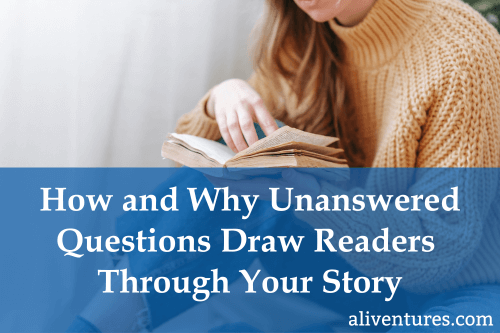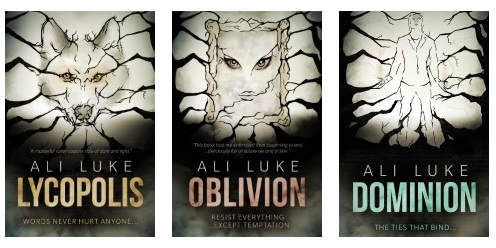How and Why Unanswered Questions Draw Readers Through Your Story

What grips readers and keeps them reading?
As a reader, there are lots of reasons why I might get really into a book … but one big factor is unanswered questions.
One of the times I notice this most is when I’m reading to my kids at bedtime. The books they want aren’t necessarily of the greatest literary merit. (A shout-out, however, to the authors who are diligently churning out book after book featuring characters in under-12s football clubs … my kids love them!) Despite these stories’ somewhat formulaic nature, I’m often tempted to read just a few more pages to see what happens next.
Unanswered questions are a really powerful way to keep your readers hooked on your story.
How to Use Unanswered Questions in Your Story
The questions you raise shouldn’t generally be explicitly asked (“will Sam escape the bullies?” or “where is Auntie Joan going every night at 2am?”) – that would seem a bit intrusive and heavy-handed.
Instead, most unanswered questions will simply emerge from your narrative. They might be about the past or the future. Here are a couple of examples from the stories I’ve been reading the kids recently:
- Past: Why is Jamie’s football coach so antagonistic towards his grandad?
- Future: Will Jed’s family’s financial situation improve?
Here are some different types of unanswered questions you might try.
Type #1: Will the Character Get Out of Trouble/Danger?
This is a really basic form of unanswered question that will arise in some way in most stories. Your protagonist is in some kind of trouble or danger … and you don’t know how (or even if!) they’ll get out of it.
Example: The Hunger Games has this in spades, from the point where Katniss volunteers as tribute to take her little sister’s place.
How to Use It
Set up a worrying or dangerous situation in your story that isn’t resolved too quickly: perhaps it takes a chapter or two, or more, for the character to get out of it. If you’re writing a thriller or adventure story, the whole thing might be driven by a strong sense of danger.
Why it Works
Assuming that the reader cares about your characters (and you can generally make us care by making a reasonably likeable character suffer), we want to know that they’ll be OK! Put them in a dangerous or tense situation and we’ll be eagerly turning pages.
Type #2: Will the Character Succeed in Reaching Their Goal?
Your protagonist will have some kind of goal (anything from “survive till tomorrow” to “save the entire world”) and one major question that drives your story is whether or not they’ll succeed in that goal.
Example: The whole Harry Potter series is driven by the question Will Harry defeat Voldemort?
How to Use It
Give your character a clear goal early on in your story, and make it important to them – and to us, the reader. You might want to include so many obstacles that we wonder whether they’ll even make it at all, raising the stakes of this question.
Why it Works
We want to see good characters triumph. We love to see people who we like and care about achieving what they’ve set out to do, especially if it means overcoming the odds.
Type #3: What’s the Answer to This Mystery?
As the storyteller, you can easily introduce more questions through missing information. That means having something that the reader (and the main character) don’t yet understand about an event, situation, person, or setting. Murder mysteries are a great example of this (and often fantasy literature).
Example: At the start of Project Hail Mary, a science fiction novel, the protagonist wakes up on a spaceship with no memory of how he got there.
How to Use It
Give us a mystery that’s important to the main character, and one that lets us dig deeper into the story world. Don’t make things mysterious or confusing for the sake of it, and don’t hide information that’s blatantly obvious to your main character. You’ll quickly annoy your readers!
(I do think you can get away with this in a short story if you’re writing a twist ending: the reader hasn’t had long enough to get aggravated…)
Why it Works
Many readers enjoy puzzles: they might relish the challenge of trying to figure out who the murderer is before the detective’s grand reveal, for instance. Others are simply curious and want to keep reading to learn what’s happened and why.
Type #4: Will This Character Learn From Their Mistakes?
Some characters start out with plenty of inner strength and the ability to make the right choices (for themselves and for those around us). Others have a long way to go! If a character has screwed up in some way, if they’re unable to stand up against others, if they’ve got into difficulties through their own actions, then we’ll be wondering if they’re capable of change.
Example: Near the start of The Reading List, 17-year-old Aleisha is unreasonably rude to elderly Mukesh when he visits the library she’s working in for the summer. Thankfully, she learns to be a nicer person quite quickly.
How to Use It
You can use this one in smaller ways or to drive a whole story. I’d maybe be cautious about having a character who constantly screws up in the same way over and over (twice is probably enough to establish the pattern; a third time will feel like overkill!) You don’t want your reader to get so bored or frustrated that they give up.
Why it Works
One of the reasons we enjoy stories is because we want to see characters learn and grow: to overcome their past mistakes or faulty thinking, to stand up for themselves, or to get along better with others. If a character we care about has been making their own life harder through their mistakes, we might be reading on to find out if they’ll be able to change.
Watch Out For Small, Nagging Questions
In the course of writing a whole novel, it’s easy to lose track of the smaller questions you might have introduced. Perhaps you had a little detail early on about a mysterious letter or half-overheard conversation that was only tangentially relevant to the plot, so you forgot to tie up that loose end. This is what TV Tropes calls “What Happened to the Mouse?”
While some readers may not notice or will forget these questions, others may have been mentally hanging on to them during your novel … so do make sure you answer them in some way.
Unanswered questions are a great way to draw readers into your story and keep them eagerly turning the pages. They’re not difficult to use and they’re also something you can often introduce in a second or third draft, if you feel your first draft needs a bit more tension.
As a reader, look out for the unanswered questions that are keeping you reading – there might be more of them than you’d initially think! It’s often easy to see the questions that drive a whole novel (like “were the babies swapped at birth?” for In a Single Moment) but you’ll often find there are smaller questions, resolved part-way through the story, too.
About

I’m Ali Luke, and I live in Leeds in the UK with my husband and two children.
Aliventures is where I help you master the art, craft and business of writing.
Start Here
If you're new, welcome! These posts are good ones to start with:
Can You Call Yourself a “Writer” if You’re Not Currently Writing?
The Three Stages of Editing (and Nine Handy Do-it-Yourself Tips)
My Novels

My contemporary fantasy trilogy is available from Amazon. The books follow on from one another, so read Lycopolis first.
You can buy them all from Amazon, or read them FREE in Kindle Unlimited.

0 Comments